Groundwater arsenic in the Red River delta, Vietnam ... - Fiva
Groundwater arsenic in the Red River delta, Vietnam ... - Fiva
Groundwater arsenic in the Red River delta, Vietnam ... - Fiva
Create successful ePaper yourself
Turn your PDF publications into a flip-book with our unique Google optimized e-Paper software.
Postma et al., submitted to Geochim. Cosmochim. Acta<br />
3.3 Incubation experiments<br />
Sediment <strong>in</strong>cubation experiments were carried out <strong>in</strong> parallel for unamended sediments<br />
and sediments with added acetate. The objective of acetate addition was to check<br />
whe<strong>the</strong>r <strong>the</strong> availability of reactive organic carbon did limit <strong>the</strong> rate of <strong>the</strong> redox<br />
processes <strong>in</strong> <strong>the</strong> system.<br />
The unamended river mud sample (Fig. 8) showed after an <strong>in</strong>itial lag<br />
period of a few days an almost l<strong>in</strong>ear <strong>in</strong>crease <strong>in</strong> both Fe 2+ and total As over <strong>the</strong> entire<br />
<strong>in</strong>cubation period of 30 days. A low concentration of As(V) was identified after 13<br />
days, but generally nearly all <strong>arsenic</strong> is present <strong>in</strong> solution as As(III). Addition of<br />
acetate did not have a great <strong>in</strong>fluence on <strong>the</strong> As and Fe release rates although <strong>the</strong> Fe<br />
release seem to be enhanced somewhat. In <strong>the</strong> case of <strong>the</strong> <strong>in</strong>cubated river sand, (Fig. 8)<br />
low Fe and As contents appear <strong>in</strong> solution after five days but <strong>the</strong>re is no fur<strong>the</strong>r <strong>in</strong>crease<br />
<strong>in</strong> concentration over time. Addition of acetate resulted <strong>in</strong> <strong>the</strong> stimulation of both <strong>the</strong><br />
release of Fe and As. Aga<strong>in</strong> most <strong>arsenic</strong> is present <strong>in</strong> solution as As(III).<br />
The unamended oxidized aquifer sediment (Fig. 9) did not show a<br />
significant release of As or Fe over <strong>the</strong> 50 day <strong>in</strong>cubation period. However, addition of<br />
acetate resulted, after an <strong>in</strong>itial lag period of a few days, <strong>in</strong> a rapid <strong>in</strong>crease <strong>in</strong> both Fe 2+<br />
and <strong>arsenic</strong>. About 70% of <strong>the</strong> <strong>arsenic</strong> <strong>in</strong> solution is present as As(III) while <strong>the</strong><br />
rema<strong>in</strong>der is <strong>in</strong> <strong>the</strong> As(V) oxidation state. In <strong>the</strong> case of <strong>the</strong> unamended reduced aquifer<br />
sediment <strong>the</strong>re is a small but steady <strong>in</strong>crease <strong>in</strong> As and Fe over <strong>the</strong> <strong>in</strong>cubation period.<br />
Aga<strong>in</strong> <strong>the</strong> addition of acetate resulted <strong>in</strong> an enhanced release of As and Fe, quite similar<br />
to <strong>the</strong> pattern observed <strong>in</strong> <strong>the</strong> oxidized zone, and aga<strong>in</strong> with a significant part of <strong>the</strong> As<br />
be<strong>in</strong>g present as As(V).<br />
16





